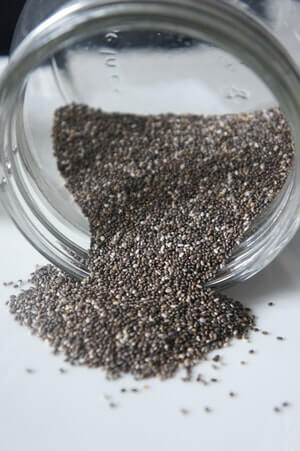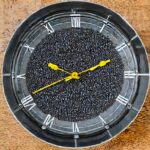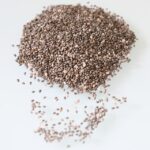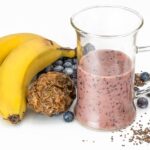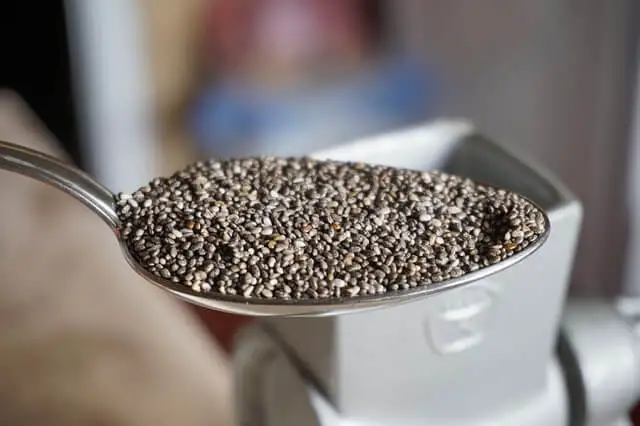
Chia seeds are great for our health and a wonderful source of nutrition that are easy to add to the daily foods we are eating.
But how much chia seeds should you eat per day? What’s an acceptable amount?
- Why Should You Eat Chia Seeds Every Day?
- Are Chia Seeds Good for You Everyday?
- How Much Chia Seeds Should You Eat Per Day?
- What’s a Good Chia Seed Dosage?
- How to Eat Chia Seeds
- How Much Chia Seeds Per Day to Lose Weight?
- How Much Soaked Chia Seeds Per Day?
- How Much Chia Seeds Per Day for Constipation?
- How Much Chia Seeds Per Day for Omega-3s?
- How Much Chia Seeds Per Day in Water?
- How Much Chia Seeds Per Day for Toddlers?
- How Much Chia Seeds Per Day for Babies?
- Are There Any Dangers of Chia Seeds?
Why Should You Eat Chia Seeds Every Day?
Chia seeds come from the Salvia Hispanica plant and are a great nutritious superfood that provides many health benefits. (See Chia Seeds Benefits)
Chia seeds are good for providing lots of fiber to your diet, providing Omega-3 fatty acids, plant-based protein, helping with weight loss, preventing heart disease and improving heart health, managing blood pressure, and managing blood sugar.
Chia seeds are easy to eat. Adding chia seeds to your current foods is an easy way to get extra chia seeds in your diet or you can even add chia seeds to baked goods.
Are Chia Seeds Good for You Everyday?
You can eat chia seeds every day and it is great for your health to do so. Chia seeds provide great plant-based Omega-3 fats, protein, a good mix of amino acids, fiber, antioxidants, minerals, and nutrients.
How Much Chia Seeds Should You Eat Per Day?
In order to maximize health benefits without consuming too much, a good amount of chia seeds to eat per day is 1-4 tablespoons, spread throughout the day. You can still get some of the chia seed benefits by eating less, and it is acceptable to just eat 1 or 2 tablespoons per day, starting out with only 1 tsp of chia seeds everyday, and increasing this amount as you feel comfortable.
This is especially true if you are already eating a fairly healthy diet and getting lots of fiber elsewhere.
If you wish to get more health benefits from chia seeds, you could eat 4 tablespoons or possibly higher (but not too high). Be aware that this will introduce a lot of extra fiber into your diet. So gradually increase the amount first before consuming this much.
Make sure that you are drinking enough water each day as well when eating chia seeds. An increase in fiber means that your body will also need more water to process that fiber.
If you are new to chia seeds, you might want to start by eating only about a tablespoon of chia seeds on the first day, to see how your body reacts. Although chia seeds are natural food, and there is no great cause for concern when eating chia seeds, they do have lots of fiber. If you are someone who is not used to eating fiber, this could give you some bloating or digestive issues until your body adapts to eating more fiber.
You can increase the amount of chia seeds you eat per day by a tablespoon after this and see if your body reacts ok to this dosage of chia seeds. You can continue adding 1 tablespoon of chia seeds in this manner until you get to the amount of chia seeds that you want to consume per day.
Video link: How Much Chia Seeds Should You Eat Per Day?
What’s a Good Chia Seed Dosage?
Chia seeds have lots of fiber in them. In fact, 2 tablespoons of chia seeds pack a whopping 10 grams of fiber. For most adults, this is roughly 1/3 of your daily needs. And for women, this is almost half of your daily fiber requirements.
The recommended fiber intake for women is 25 grams daily, and for men, it’s 38 grams. This means that 2 tablespoons, will be giving you a good amount of your daily requirements. Most people (actually 95% of Americans or so) fall short of this daily number. But, most people get at least 10-15 grams from their other sources of food that they eat the rest of the day.
So, for a female, 2 tablespoons of chia seeds might give them enough extra fiber to hit this number. A male might need to eat more chia seeds or more high-fiber foods in the rest of their diet to hit the 38-gram mark for men. But it will depend on how much other fiber you are eating in your diet.
So if you are someone eating a high-fiber or a healthier diet, you might need to eat on the lower end of the spectrum of chia seeds per day, around 1-2 tablespoons. If you are someone who lacks fiber in their diet, you might need to eat a higher dose of daily chia seeds of 4-5 tablespoons.
If you are eating chia seeds for the Omega-3s, we will discuss that later.
How Much is Too Much Chia Seeds?
You may want to avoid going over 4 or 5 tablespoons of chia seeds per day. And when you first start out eating them, this number should be even lower.
Just remember that chia seeds are very high in fiber, even though you are consuming a little amount of them. This is a good thing since fiber is so good for us, but at the same time, you might need to be careful about how much chia seeds you are consuming because of this.
While there is no limit set by the Institute of Medicine for the amount of fiber you can eat per day, you might want to avoid going too high, especially if you aren’t used to eating fiber. At a high intake of fiber, around 70 grams per day, there might be uncomfortable and negative side effects of bloating, gas, or cramping.
Even excesses of 50 grams of fiber per day might cause problems as well. Whereas fiber is great for you, there might be a point at which too much fiber makes it hard for your system to digest and it may be more fiber than your system actually needs.
You also want to avoid eating too many chia seeds if you are not used to eating fiber. If this is the case, you want to limit your fiber intake from the chia seeds until your body can adjust. Start with 1 tablespoon per day and increase by 1 tablespoon or 1/2 a tablespoon only when you see that your body can handle the fiber from the chia seeds.
How to Eat Chia Seeds
Chia seeds can either be eaten raw, soaked in water, or ground up before eating. While it’s perfectly acceptable to eat chia seeds raw, there are some additional benefits to soaking or grinding chia seeds first. This is because it increases their overall digestibility.
Chia seeds can be added to a number of your favorite foods and dishes. They can even be added into oatmeal, smoothies and baked goods. Some people even choose to drink chia water throughout the day. You can find plenty of ideas and ways to eat chia seeds at How to Eat Chia Seeds.
Best Time to Eat Chia Seeds
The best time to eat chia seeds is to start in the morning with breakfast. One can easily add 1-2 tablespoons to your breakfast such as oatmeal or porridge or by eating chia pudding.
Eating chia seeds in the morning can help you to feel full longer, and also supply your body with fiber and some protein. You can then add some chia seeds to your lunch or dinner (another 1 tablespoon at each meal if you like) or you could drink chia water throughout the day.
If you are using chia seeds to relieve constipation, then it’s recommended to take about 2 tablespoons with plenty of water before going to bed. Or try to drink the 2 tablespoons throughout the day.
(Learn more at Best Time to Eat Chia Seeds)
How Much Chia Seeds Per Day to Lose Weight?
If you are taking chia seeds to lose weight, then 4-5 tablespoons a day can be a good amount to eat. But only after you have started with a smaller amount and increased as you see that your body can handle the fiber from the chia seeds.
Chia seeds help you with weight loss because the soluble fiber can slow the digestion of food, and also the chia seeds expand even more in the stomach, making you feel more full and satiated, which might help you to eat less. Also, they help stabilize your blood sugar, which can help if you are dieting.
(Learn more at How Much Chia Seeds Per Day to Lose Weight)
How Much Soaked Chia Seeds Per Day?
The amount of soaked chia seeds you eat per day is greater than the amount of raw or ground chia seeds that you would eat. This is because soaked chia seeds have a lot of water or other liquid added to them. So to get the same amount of chia seeds, you would need to consume a larger amount of the soaked chia seed gel.
Since usually the ratio of chia seeds to water in soaked chia seeds is about 1 to 4 (1:4) or 1 to 5 (1:5), then you would need to consume about 4 to 5 times as much soaked chia seeds to get the same amount of chia seeds as if you ate them dry.
Since the recommended amount of raw chia seeds per day is 1-4 tablespoons, then you would want to consume 4-16 tablespoons of soaked chia seeds per day (or 1 cup). When you first start out and you are eating 1-2 tablespoons of raw chia seeds, this would be the same is 4-8 tablespoons of soaked chia seed gel.
You could go even higher than this depending on how thin your soaked chia seeds are. If you used a 1:6 ratio then you could consume 24 tablespoons to get the same amount. And if you normally consumed 5 tablespoons of dry chia seeds per day, you could consume 20-30 tablespoons of soaked chia seeds.
How Much Chia Seeds Per Day for Constipation?
If you are taking chia seeds for constipation, start with taking 2 tablespoons of chia seeds at night before bed. Drink plenty of water with them. This will hopefully help you by the morning time.
Another option is to just take the chia seeds throughout the day.
How Much Chia Seeds Per Day for Omega-3s?
Chia seeds are very high in plant-based Omega-3 fatty acids, called ALA. In fact, they are one of the highest plant-based sources of Omega-3s. Because they are so high in Omega-3s, you really don’t have to take a lot of chia seeds in order to get a lot of Omega-3 fats as well. (See Chia Seeds and Omega-3s)
In fact, 2 tablespoons of chia seeds will give you around 2.6 grams of ALA. It’s recommended that adult females get 1.1 grams of ALA daily, and adult males get 1.6 grams of ALA daily. These amounts can be met for women by eating a tablespoon of chia seeds, and around 1.5 tablespoons for men (but they may need to be ground or soaked as we will talk about next). There is no upper limit to ALA, so eating more than this amount to ensure you get enough, would be a good practice.
But, it should be noted that the chia seeds may need to be ground or soaked in order to fully absorb the ALA from them. Some studies have shown that ground and soaked chia seeds consumption resulted in higher ALA and EPA levels in the bloodstream, with ground chia seeds having the highest impact. Whole chia seeds however did not raise ALA levels.
So if you are taking chia seeds for Omega-3 fats, you may need to soak or grind the chia seeds in order to get the Omega-3 fats from the chia seeds.
That covers ALA levels, but what about the Omega-3 fats EPA and DHA? Plant-based food sources like chia seeds do not provide EPA and DHA. These are only obtained from fish or seafood sources. But, the body can convert ALA to EPA and DHA using plant-based sources, but the conversion is not extremely efficient, so enough must be consumed in order to get enough EPA and DHA.
The conversion rates for ALA to EPA are around 8% to 20% of ALA being converted to EPA in the body, and 0.5% to 9% for the conversion of ALA to DHA. The differences depend on the age, health, and genetics of the individual, and also females convert at a higher rate than males, especially for DHA.
In a study involving ground chia seeds, postmenopausal women who supplemented with ground chia seeds saw their blood levels of ALA increase by 138% over their baseline after only a week. EPA levels also increased, but at a lower rate of 30% above baseline. But still, ALA was probably being converted into EPA.
The recommended amount of EPA and DHA in the diet is 250-500mg daily. Although it’s hard to know what the conversion rate of ALA to EPA is for each individual, if we use the lowest conversion rate of 8%, then 2 tablespoons of chia seeds with 2.6 grams of ALA, will convert to around 208mg of EPA. If someone converts at a higher rate, then this number could be higher.
This means that if you aren’t eating any fish or other sources of EPA and DHA in the diet, you might be able to get your EPA from chia seeds (or other plant-based sources), as long as you are eating enough. Since the recommended amount of EPA is 250mg on the low end, it’s probably better to aim for a higher level of 500mg to be safe.
If you are not eating fish, this could potentially be done by eating around 4 tablespoons of ground chia seeds per day (or soaking the 4 tablespoons of chia seeds).
How Much Chia Seeds Per Day in Water?
If you are eating your chia seeds by putting them in water and drinking chia water throughout the day, you can consume 2-4 tablespoons per day. You can start out at 1 tablespoon per day to make sure your body can handle the fiber, and then increase by 1 tablespoon until you reach the amount of chia seeds you want to eat daily.
If you want to get even more fiber, you could go higher and eat 5 tablespoons, but work your way up to this amount first to avoid an upset stomach.
How Much Chia Seeds Per Day for Toddlers?
Toddlers could eat up to 1 tablespoon (3 teaspoons) of chia seeds per day. Make sure to soak the chia seeds first, in order to avoid any choking hazards. Or, add them to baked goods or a smoothie.
How Much Chia Seeds Per Day for Babies?
Babies from 6-12 months can have up to 1 teaspoon of chia seeds per day. Make sure they are soaked first before giving them to avoid any risk of choking.
(See Soaked Chia Seeds Guide)
Are There Any Dangers of Chia Seeds?
Chia seeds are pretty safe. They are a natural food, so there are not a lot of dangers to eating chia seeds. But there are a couple of things to be aware of.
Although extremely rare, there have been chia seed allergy reports.
Another very rare occurrence happened when a man ate too many chia seeds at once and they expanded in the esophagus, restricting his airway. This has only happened once, but you can prevent this by either soaking the chia seeds, or adding them to another food, and not eating too many dry chia seeds at one time. Also, drink plenty of water with chia seeds.
There are a couple of other reasons to potentially avoid chia seeds if you are on certain medications. (Disclaimer: This is not a site for medical advice and I am not a medical professional. Please consult your doctor before making any changes, or about any questions you might have). It is recommended on some medical sites to avoid chia seeds if you are on blood thinners or blood pressure medication. This is because the Omega-3s in chia seeds can thin the blood even more, and they have the potential to lower blood pressure, which might lower blood pressure too much when taken with a blood pressure medication.
Another time to avoid chia seeds is if you are on diabetic medication since chia seeds can lower blood sugar levels. This could affect diabetic medication such as insulin. (Learn more at Chia Seeds Side Effects in Females and Dangers of Chia Seeds)
Generally, chia seeds are fairly safe for consumption, as long as you eat them in moderation and are mindful of your body, and any potential effects you might be experiencing.
Lance has been passionate about the plant-based diet and we have been following a whole food plant-based diet for over 5 years. We focus on health, natural healing, weight management, animal rights, and the health of the planet and environment by focusing on whole plant-based foods and sustainable practices.
Learn more at the About Me page and follow on social media at the links below.


